How Long Do You Pressure Can Fully Cooked Beef Vegetable Soup
Canning soup at home is a wonderful way to have quick lunches ready. There are just a few things to remember:
- Can you can soup without a pressure canner? No, soups will always need to be pressure canned.
- Do not add noodles, rice, flour, cream, or any milk or thickeners. All of these can be added when you heat the soup to serve it.
- If you are using beans or peas, they must be cooked prior to canning.
- The only ingredients you should use are ingredients that are safe to can. So that means since cabbage does not have a tested method of canning just by itself, it is not considered an acceptable ingredient. (I know! I hate that!) Sauerkraut is a pickled item, so that is different than canning just plain cabbage.
- With these considerations in mind, canning vegetable soup at home is possible.
- I have a recipe for canning homemade chicken soup on this page.
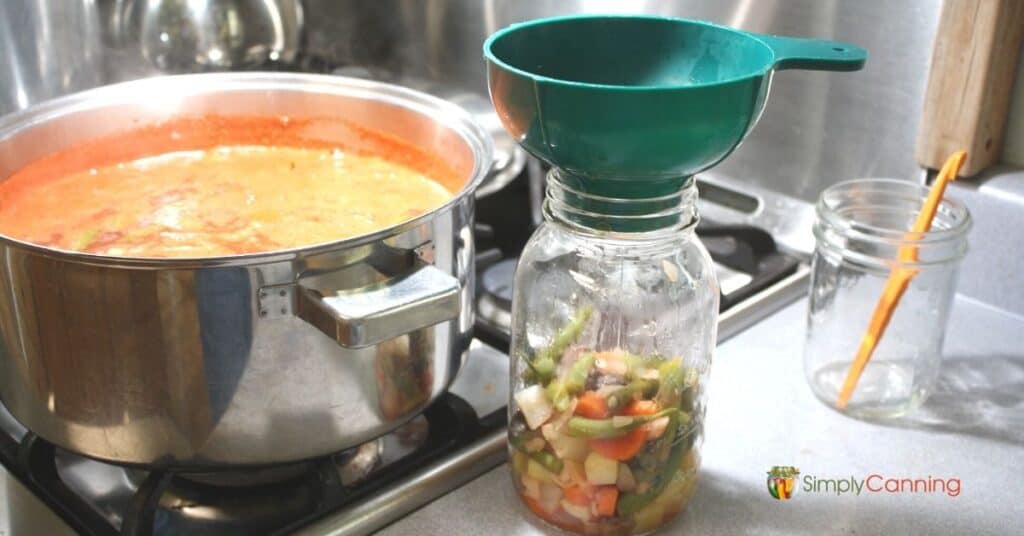
This Page Includes:
- Canning Soup: Extended, Step-By-Step Directions
- Recipe Card
- {Video} Canning Soup Tips
- {FAQ} What About Canning Cream Of Soups, Butternut Squash Soup, Tomato Soup, & Other Pureed Soups?
- {FAQ} Home Canning with Seasonings
- {FAQ} How Much Liquid to Put in the Jar?
- {Video} Can Vegetables Be Fully Cooked for Home Canning Soup?
- {FAQ} Canning Venison Soup
- {FAQ} Canning Potato Soup
- {FAQ} More on Canning Pureed Soup
- {FAQ} Some Oil/Grease Left in the Soup?
- {FAQ} Can I Add Sour Cream While Canning Soup?
- {FAQ} How Long Will Homemade Soup Last in a Canning Jar Once Processed?
- Members' Extra
Canning Soup: Extended, Step-By-Step Directions
First, cook any meats and vegetables. (Remove bones after cooking.)
If you are canning soup with beans, cook them by covering dried beans with water by a couple of inches. Bring to a boil and simmer for 2 minutes. Remove from the heat and let soak for at least 1 hour. Drain.
Combine all solid ingredients and add whatever broth you may be using: chicken broth, beef broth, canned tomatoes, or water. Add spices and seasoning at this point as well. (See below for an important tip on seasonings.) You need at 2 times more liquid than solid ingredients.
Bring to a boil and simmer for 5 minutes.
Remember: No dairy, thickeners, pasta, or rice when canning soup. These ingredients can be added later when you serve the soup.
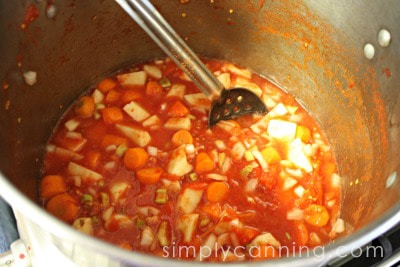
Fill your jars. Fill each jar about halfway full with the solid ingredients. (I use a slotted spoon.) Then add the liquid to cover, leaving a 1-inch headspace.
There is a safety reason for this half solids and half liquids recommendation. The gist of it is that you want the heat to penetrate fully to the center of the jar. If your soup is too thick, it may not do so. With the wide variety of ingredients possible with these adaptation directions…half solid/half liquid will ensure that your ingredients are heated through.
In this image, you can see several jars where I've added the solids, then one jar on the right where I've added the liquid.
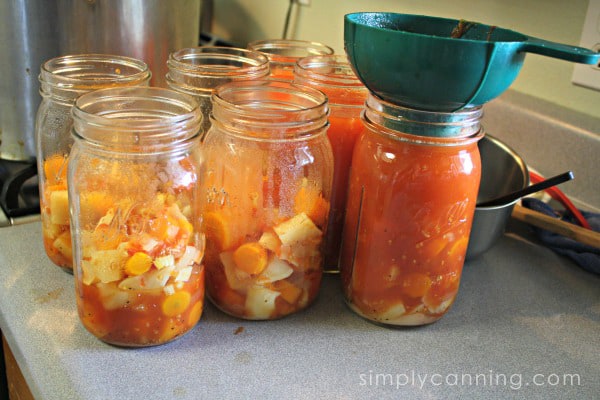
Having extra liquid can also be helpful if you'll be adding noodles or rice when you serve it. (Don't put noodles or rice in the jar! Canning soup a little…soupy…is a good thing.
Home Canning Vegetable Soup
Place your lids and process following pressure canning instructions.
Process pints 60 minutes, quarts 75 minutes. (If you are canning soup with seafood, you will need to process either pints or quarts for 100 minutes.)
Be sure to adjust processing according to your altitude using the charts below. For more information see this altitude adjustments page.
Recipe Card
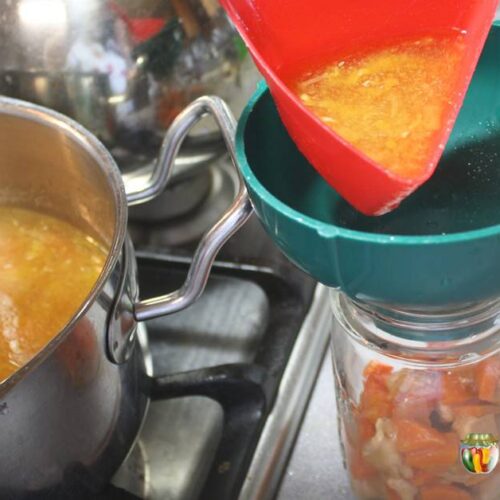
Canning Soup
Canning Soup
Course Side Dish
Cuisine American
- Meats like beef, seafood, poultry, etc.
- Vegetables & beans
- Broth like chicken broth, beef broth, canned tomatoes, water, etc.
- Spices & seasonings
-
Start by preparing your jars and getting water in the canner heating. You want the canner hot, but not boiling, when the jars are ready to be processed.
If you are new to using a pressure canner, see this article for full pressure canning instructions. This includes more detailed information and step-by-step instructions on how a pressure canner works.
For a Hot Pack
-
Precook meats by covering with water or broth. Boil until tender. Remove bones.
-
Precook vegetables according to hot pack instructions for that vegetable.
-
Precook beans by covering with water by several inches. Boil for 2 minutes. Remove from the heat, cover, and let soak for 1 hour. Drain.
-
Combine all solid ingredients with seasonings and your choice of broth, tomatoes, or water. You will need at least 2 times more liquid than solid ingredients.
-
Bring to a boil for 5 minutes.
-
Fill jar half of the way with solid ingredients.
-
Top off jar with broth, leaving 1" headspace.
-
Remove bubbles, wipe the rim clean, and place on seal and ring. Place jar in the warm canner. Proceed to fill all jars. Process in a pressure canner according to the directions below.
Processing with a Pressure Canner
Place the jars in the warm canner. Proceed to fill all jars placing them in the prepared hot canner.
Put the lid on the canner leaving the weights off. Bring to a boil. Watch for the steam to start coming out the vent pipe in the lid.
Allow the steam to 'vent' for 10 minutes then put the weights on. Use the proper weight for your altitude (check the chart below) This is when pressure will start to build.
When the pressure reaches the pressure required for your altitude (check the chart below) that is when you'll start your time. Process for the full time indicated, adjusting the heat as needed to maintain the correct pressure for the entire time.
When processing time is completed turn off the heat. Do not remove weights yet. Let the canner sit undisturbed until pressure comes back to zero. Do not try to speed up the cooling process.
Remove the weight and wait 5 minutes.
Open the lid to allow steam to escape. (carefully don't let it hit your face or arms!) Leave the lid setting on top of the canner slightly ajar and wait 5 minutes.
Take the lid off the canner and remove your jars. (optionally you can wait another 5 minutes if the contents appear to be bubbling so hard it is coming out of the jars)
Put the jars a few inches apart on a thick towel and allow them to cool to room temperature undisturbed. 12 hours is suggested.
When the jars are cool, remove the metal bands, check the seals, and store the jars in a cool dark place.
Processing Instructions (Hot Pack)
Process pints for 60 minutes or quarts for 75 minutes, adjusting for altitude. (If canning with seafood, process pints or quarts for 100 minutes.)
Altitude Adjustments for Pressure Canner
Altitude – Weighted Gauge
0-1,000 ft – 10 pounds
1,001-8,000 ft – 15 pounds
Altitude – Dial Gauge
0-2,000 ft – 11 pounds
2,001-4,000 ft – 12 pounds
4,001-6,000 ft – 13 pounds
6,001-8,000 ft – 14 pounds
Adapted from: The National Center for Home Food Preservation
Last Updated: 5/24/2021
Canning Soup Tips & FAQs
Canning Soup Tips Video
What About Canning Cream Of Soups, Butternut Squash Soup, Tomato Soup, & Other Pureed Soups?
It is not recommended that you can pureed-style soups, so I do not give directions for this.
However, what I would do is make the soup and can it prior to pureeing! Just can it chunky (kind of like canning vegetable soup). Then when you open the jar to serve it, puree it at that point. Simple solution!
Home Canning with Seasonings
Remember, some seasonings get strong when canned. For instance, sage is one that is noted for getting too strong. If you use bay leaves in your soup, be sure and remove them before you jar it up. The particular jar that ends up with the leaf will be very strong if you leave it! I keep our seasonings very simple. Salt and pepper are what goes in most things in my pantry.
How Much Liquid to Put in the Jar?
In the directions below, you'll notice I state to first fill your jar half of the way with solids, and then top them off with your liquid. Filling each jar about halfway full with solid ingredients is a safety issue. Please do not skip this. If you have half solid and half liquid, the heat will penetrate fully throughout the jar.
Be sure you have enough broth that you will be able to cover the solid ingredients in the jar. You'll want twice the amount of liquid to solid ingredients. If you realize you will not have enough liquid to fill your jars, there is a simple fix: Top off the jar with a bit of hot chicken broth or water.
Quick Canning Soup Tip
If you realize you will not have enough liquid to fill your jars, there is a simple fix. Evenly distribute the soup base you do have. Then, if needed, top off each jar with a bit of chicken broth. (Heat it up first.) This has worked well for me.
You could just add water if you don't have extra broth, but it may dilute the flavor if you add too much. If you only need a little bit of extra liquid, hot water works fine.
Can Vegetables Be Fully Cooked for Home Canning Soup?
Video Transcript – Edited for Clarity
This question comes from Karen in Canada. She asks, "Hello, I was wondering about canning soups with vegetables. I have found they can get mushy when being processed for so long. Is it possible to cook just a little and then let them finish cooking while processing?"
Actually, Karen, that is exactly what you do when you're canning soup with vegetables. To properly can your own soup recipe, you partially cook those vegetables. You only partially cook those veggies and then combine everything together.
You simmer it, and then you put it in your jars and process. I don't know this from your letter, but I've had people ask this question before. They make an overabundance of soup for supper, with the intention of canning leftovers. It doesn't work very well, because, like you said, the vegetables are fully cooked already. They will be fully cooked again in the canner, and then you'll end up with soft vegetables. Don't count on canning leftovers. Prepare the food specifically for canning instead.
If you have leftovers, just put them in the freezer for later. When you're making your vegetable soup, follow the directions and techniques for adapting your recipe to be safe for home canning. You should have a good product in the end.
I hope that was helpful. You guys have a great day, and we will see you in the next video!
Canning Venison Soup
"How safe is what I'm doing? I make a large pot of venison vegetable soup, tomato based, boil the noodles separate, put the noodles in the sterilized jar, bring the soup to a boil and fill the jar. That's it."
Answer:
Hi Tom,
Yes, canning your own venison vegetable soup is okay. However, soups should not be canned with any pasta, thickeners, or dairy products. What you should do is can the soup without the noodles, and then just add the noodles when you open the jar later. Also, you really MUST pressure can soup. Botulism is a risk, so any vegetables or meat (and your soup contains both) must be pressure canned.
Canning Potato Soup
"Sharon, I made a big Crockpot full of potato soup, and all that was left I decided to can for later…when I opened one of the jars it was spoiled…what did I do wrong?? I love checking your site for different ideas and recipe… please keep them coming, and in advance, thank you for your help with this."
Answer:
It is hard to say without knowing just what was in your soup and how you processed it. My guess is you have cream or some other dairy in your soup. And unfortunately, that is not recommended for canning.
More on Canning Pureed Soup
"Hello Sharon, I have read that you should not be canning pureed soup and I am wondering if this is true and why not? Also if I make vegetable soup and put small, cooked pasta in it, can that be canned? Thank you for sharing your knowledge and your support.
Answer:
Karen, it is true that canning pureed soup is not advised. There have been no tests done to determine safety. It all has to do with the density of purees. What you can do is can your ingredients and then puree the soup when you serve it. Use regular safety measures like any other canned soup.
And it is also true that pasta has not been tested for safety in home canning. I get comments all the time saying that since commercially canned soups contain pasta, we can do it also. But the issue is equipment.
Commercial processes use different equipment than home canners have available. We cannot assume that if we can buy soups with pasta or rice that it is still safe to add the same ingredients for home canning also. It is not.
Some Oil/Grease Left in the Soup?
"I canned some vegetable soup with turkey sausage. I followed the USDA website canning guidelines for canning soup. The soup has set for 24 hours, and I have removed the screw bands and checked the seals, which are good. However, I have noticed that there is a slight oily layer on top of the soup. I drained the turkey sausage before adding it to the soup, but obviously did not get it all. I have read that fat cannot be safely canned, but is a very slight oily layer on top okay?"
Answer:
Yes, when you are canning soup with meat, there may be some oils left in your soup. That is fine. You do want to get as much fat out as you can, but some may remain. As long as you drained the meat and followed all the other safety precautions, it is not a problem.
Can I Add Sour Cream While Canning Soup?
"I have a wonderful recipe for potato soup, which has quickly become a favorite in our household. I have canned chili, stews and other soups, but not sure on this recipe. It calls for 3/4 c of sour cream for one batch. Can I safely add this to my soup, then can it? Just not sure if the sour cream would break down during the pressure process. Thanks! Elizabeth"
Answer:
Elizabeth, it is not recommended that you can anything with dairy products. What I would do is try canning it without the sour cream or any other dairy, instead adding those ingredients later when you serve it.
Potato soup is a favorite at our house too. I almost always make it after a ham dinner with the leftover mashed potatoes and ham gravy as a base. My secret ingredient is chicken broth. The broth adds a wonderfully rich flavor. YUM!
How Long Will Homemade Soup Last in a Canning Jar Once Processed?
Generally, most home canned goods will last for at least a year. You can still use the soup, even if it has been longer than the 1-year mark, but the quality starts going down at that point. So if it has been a year, don't throw it away! Just pull it to the front of the cupboard and make a plan to use it up soon.
Related Pages
Barley Soup Recipes – Use roast leftovers and barley to make this beef barley soup. Use a Crockpot or cook it on the stove.
Homemade Chicken Soup Recipe that's safe for canning? Yes, it's here!
Homemade Chicken Broth pressure canning instructions and preserving tips.
Pin This to Find Later:
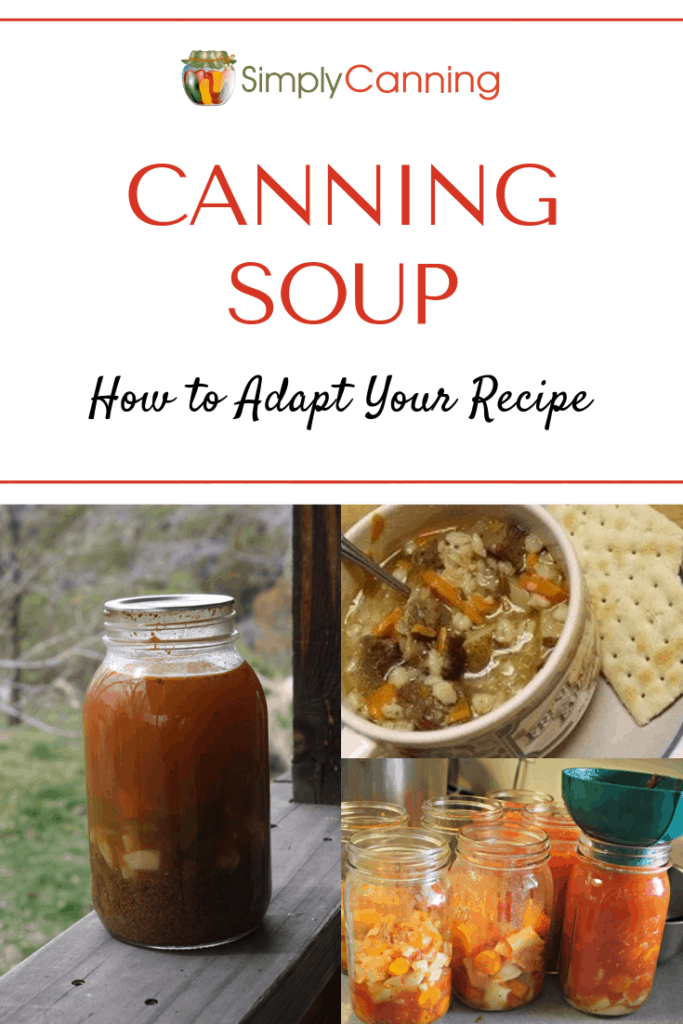
Members' Extra: Access Your Video Tutorial in Your Members Area
Canning school members, click here to log in.
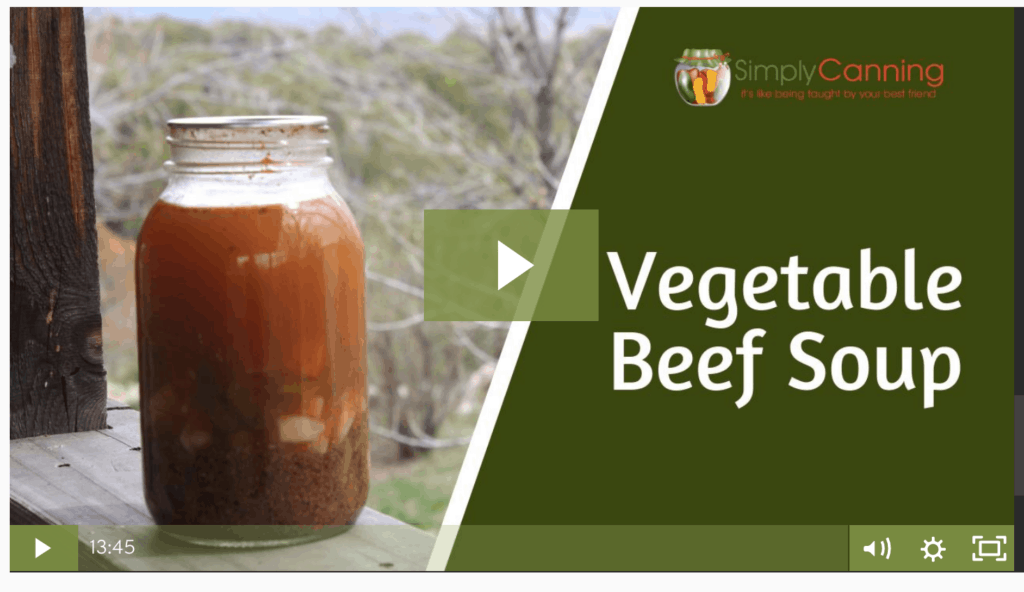
Source: The National Center for Home Food Preservation
Page last updated: 6/30/2021
Source: https://www.simplycanning.com/canning-soup/
0 Response to "How Long Do You Pressure Can Fully Cooked Beef Vegetable Soup"
Post a Comment